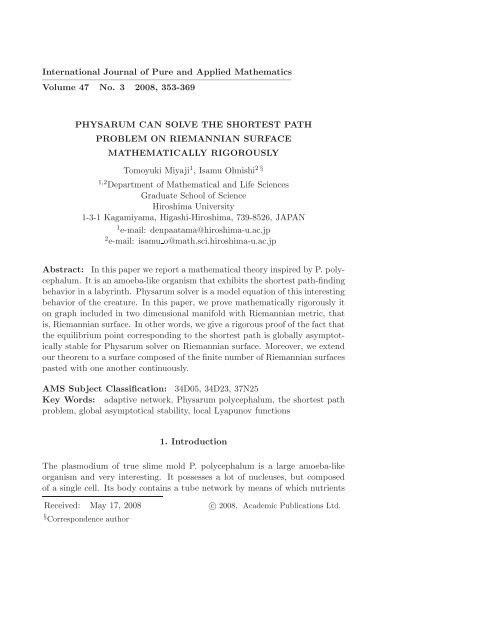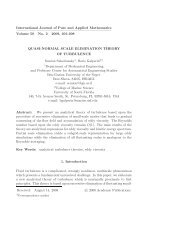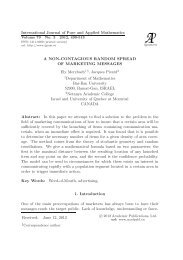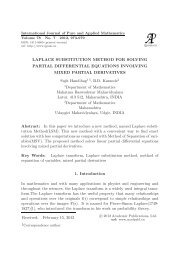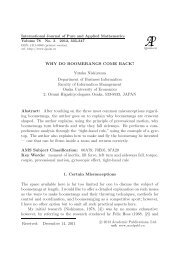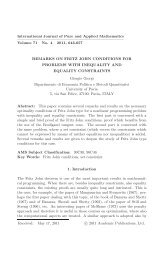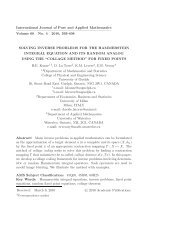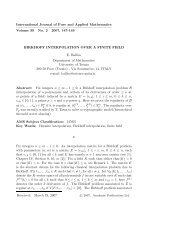PHYSARUM CAN SOLVE THE SHORTEST PATH PROBLEM ON ...
PHYSARUM CAN SOLVE THE SHORTEST PATH PROBLEM ON ...
PHYSARUM CAN SOLVE THE SHORTEST PATH PROBLEM ON ...
You also want an ePaper? Increase the reach of your titles
YUMPU automatically turns print PDFs into web optimized ePapers that Google loves.
International Journal of Pure and Applied Mathematics<br />
————————————————————————–<br />
Volume 47 No. 3 2008, 353-369<br />
<strong>PHYSARUM</strong> <strong>CAN</strong> <strong>SOLVE</strong> <strong>THE</strong> <strong>SHORTEST</strong> <strong>PATH</strong><br />
<strong>PROBLEM</strong> <strong>ON</strong> RIEMANNIAN SURFACE<br />
MA<strong>THE</strong>MATICALLY RIGOROUSLY<br />
Tomoyuki Miyaji 1 , Isamu Ohnishi 2 §<br />
1,2 Department of Mathematical and Life Sciences<br />
Graduate School of Science<br />
Hiroshima University<br />
1-3-1 Kagamiyama, Higashi-Hiroshima, 739-8526, JAPAN<br />
1 e-mail: denpaatama@hiroshima-u.ac.jp<br />
2 e-mail: isamu o@math.sci.hiroshima-u.ac.jp<br />
Abstract: In this paper we report a mathematical theory inspired by P. polycephalum.<br />
It is an amoeba-like organism that exhibits the shortest path-finding<br />
behavior in a labyrinth. Physarum solver is a model equation of this interesting<br />
behavior of the creature. In this paper, we prove mathematically rigorously it<br />
on graph included in two dimensional manifold with Riemannian metric, that<br />
is, Riemannian surface. In other words, we give a rigorous proof of the fact that<br />
the equilibrium point corresponding to the shortest path is globally asymptotically<br />
stable for Physarum solver on Riemannian surface. Moreover, we extend<br />
our theorem to a surface composed of the finite number of Riemannian surfaces<br />
pasted with one another continuously.<br />
AMS Subject Classification: 34D05, 34D23, 37N25<br />
Key Words: adaptive network, Physarum polycephalum, the shortest path<br />
problem, global asymptotical stability, local Lyapunov functions<br />
1. Introduction<br />
The plasmodium of true slime mold P. polycephalum is a large amoeba-like<br />
organism and very interesting. It possesses a lot of nucleuses, but composed<br />
of a single cell. Its body contains a tube network by means of which nutrients<br />
Received: May 17, 2008 c○ 2008, Academic Publications Ltd.<br />
§ Correspondence author
354 T. Miyaji, I. Ohnishi<br />
and signals circulate through the body in effective manner. When food sources<br />
were presented to a starved plasmodium that was spread over the entire agar<br />
surface, it concentrated at every food source, respectively. Almost the entire<br />
plasmodium accumulated at the food sources and covered each of them in order<br />
to absorb nutrients, see [9]. Only a few tube remained connecting the quasiseparated<br />
components of the plasmodium through the short path. Nakagaki et<br />
al showed that this simple organism had the ability to find the minimum-length<br />
solution of a labyrinth, see [10, 11]. The connecting tube traces the shortest<br />
path even in a complicated labyrinth. This adaptation process of the tube<br />
network is based on an underlying physiological mechanism, that is, a tube<br />
becomes thicker as a flux in the tube is larger.<br />
Tero et al made a mathematical model in consideration of the qualitative<br />
mechanisms clarified by experiments, see [13]. They considered the tube network<br />
of P. polycephalum on a labyrinth to be a plane graph, set some variables<br />
on vertices and edges of the graph, and described the process of growth and<br />
degeneracy of the tube. The model consists of two parts, equations for flux in<br />
tubes and nonlinear ODEs for adaptation of tubes. In a special case of nonlinear<br />
terms (in which the adaptation term has just a linear form), the model is called<br />
Physarum solver. According to numerical simulation results, the minimumlength<br />
solution of a labyrinth can be obtained as an asymptotic steady state of<br />
Physarum solver, see [13, 15].<br />
We have already obtained several results in intersting cases to report it in,<br />
see [5]. In this paper, we present an extension of the theorem in a further more<br />
general case on two dimensional surface, in which the length of any two points<br />
on it can be computable. We note that the first announcement of this paper’s<br />
result has been already reported in [6], but this is a little bit more general<br />
theorem proved here than it.<br />
As telling from the mathematically technical point of view, it is an interesting<br />
point that we prove the gllobally asymptotical stability without using<br />
Lyapunov function, which is defined globally in the whole space. Instead of<br />
the function, we use a kind of “weak” Lyapunov function defined in a open<br />
bounded set to operate a graph under consideration. From the viewpoint of<br />
dynamical system theory, such an operation of graph is corresponding to reduction<br />
of the system to an exponential attracting invariant set, which is the<br />
“lower” boundary of the open bounded set. We make the reduction of the system<br />
by using of “exponential tracking” property of Physarum solver (see, for<br />
instance, [3] for the detail of the reduction). This property is also proved by<br />
our “weak” Lyapunov function. Moreover, the inertial form of the system of
<strong>PHYSARUM</strong> <strong>CAN</strong> <strong>SOLVE</strong> <strong>THE</strong> <strong>SHORTEST</strong> <strong>PATH</strong>... 355<br />
equations has expressed explicitly and has a similar form to the original one,<br />
but its dimension is lower than of the original one, which can let us make a<br />
progress of it to the next step. We thus make this proceedure a lot of times to<br />
get the result. Here it is necessary for the length of each edge of the graph to<br />
be caluculated. Therefore, we put the assumption about the two dimensional<br />
surface under consideration.<br />
On the other hand, in laboratory, P. polycephalum sometimes makes a<br />
mistake, for example, when there is a kind of “double-edge” like parallel circuit<br />
in a graph. Then, it sometimes chooses a longer path. The model equation<br />
can explain this case, that is, if the adaptation term has a super-linear form,<br />
then numerical computations show that it sometimes chooses a longer path<br />
according to initial data (see [13]). We also have already studied such a case in<br />
[7] to get some mathematical results. In that paper, we explain this fact from<br />
the viewpoint of dynamical system mathematically. In the consequence, we do<br />
not only show why P. polycephalum makes a mistake, but also show how it<br />
makes a mistake. It is a kind of analysis of a simple but interesting transition<br />
process, which can be significant also in real world application. Actually, as P.<br />
polycephalum is in various situations, we can consider that it changes important<br />
parameters according to the situation. This is the reason why it sometimes takes<br />
the right answer, but sometimes makes a mistake. It is very interesting that<br />
this model can explain such a kind of mysterious behavior of the organism of<br />
life just by the subtle difference of the adaptation term.<br />
As telling about an application of Physarum solver, in [15], they have attempted<br />
to apply Physarum solver to navigation system of road map. In fact,<br />
Physarum solver has found the shortest path connecting between Seattle and<br />
Houston admirably. In such a way, as it has a lot of possibilities to apply,<br />
we here consider that it is very important to ensure the shortest path decision<br />
property of Physarum solver mathematically rigorously.<br />
Finally, we remark that the definitions, the notations and the results stated<br />
below can be extended to a surface composed of the finite number of Riemannian<br />
surfaces pasted with one another continuously, and a graph on such a surface.<br />
This is because the length of each edge are computable on the graph, even if the<br />
edge which crosses a pasted line between two surfaces exists. Therefore, we can<br />
understand a biochemical experiments in Nakagaki et al [14] recently by use<br />
of P. polycephalum where “the shortest path” is found on a non-homogenized<br />
place by P. polycephalum, in this mathematical framework. This is because<br />
Physarum solver with weight on tube can be regarded as Physarum solver on<br />
a kind of non-homogenized place by translating the weight to the field, where
356 T. Miyaji, I. Ohnishi<br />
the system of equations are defined.<br />
2. Preliminaries<br />
2.1. Graphs on Riemannian Surface<br />
Physarum solver is defined on a finite graph in Riemannian surface. First, we<br />
briefly introduce some notations. We will assume that the reader is familiar<br />
with basic terms and results from graph theory (see for details [2, 4, 8]).<br />
In Riemannian surface M 2 , a graph G = (V,E) is a pair of sets, V , E ⊂ M 2 ,<br />
where V is a nonempty and E is a set of 2-element subsets of V . Throughout<br />
this paper we assume that V is finite. The elements of V are called vertices of<br />
G, the elements of E are the edges of G. Let |G| denote the number of vertices.<br />
|G| is called the order of the graph G. The degree of a vertex v, denoted d(v),<br />
is the number of edges incident with v.<br />
Let G 1 ,... ,G k be subgraphs of the graph G. The union G 1 ∪ · · · ∪ G k is<br />
the graph H ⊆ G with V (H) = V (G 1 ) ∪ · · · ∪V (G k ) and E(H) = E(G 1 ) ∪ · · · ∪<br />
E(G k ).<br />
For U ⊂ V we denote by G − U the subgraph of G obtained by deleting<br />
from G the vertices in U and all edges incident with them. If F ⊂ E, then<br />
G − F is the subgraph of G obtained by removing from G the edges in the set<br />
F.<br />
A path is a nonempty graph P = (V,E) such that<br />
V = {x 0 ,x 1 ,... ,x k } E = {x 0 x 1 ,x 1 x 2 ,... ,x k−1 x k },<br />
where x i x j is the edge joining x i and x j . We denote P = x 0 x 1 · · · x k and call it<br />
the path from x 0 to x k , or x 0 -x k path.<br />
If P = x 0 · · · x k−1 is a path and k ≥ 3, then a graph C = P + x k−1 x 0 is<br />
called a cycle.<br />
A graph is in M 2 , if it is drawn in M 2 in such a way that no edges intersect<br />
on M 2 , except at a common end-vertex. Then, we call the graph M 2 graph. A<br />
planar graph is a simple example. For any graph G, a set M 2 \ G is an open<br />
subset of M 2 . Its region is called a face of G. Since G is bounded, one of the<br />
faces can be unbounded. The unbounded face of G is called outer face, if it<br />
exists, and the remainders are called inner faces. If M 2 is compact, then we<br />
take an adequate face in all the faces ⊂ M 2 , and we call this be outer and call<br />
the others inner (later, we choose the face including s and t on its boundary as
<strong>PHYSARUM</strong> <strong>CAN</strong> <strong>SOLVE</strong> <strong>THE</strong> <strong>SHORTEST</strong> <strong>PATH</strong>... 357<br />
the outer).<br />
Note that, in what follows, we consider only M 2 graph as a graph. Therefore<br />
we will state a graph simply, but it means M 2 graph.<br />
2.2. Physarum Solver<br />
Now, let us briefly introduce Physarum solver. The formulation and physiological<br />
backgrounds are detailed in [13] (see also [15]).<br />
Let G = (V,E) be a graph. We consider a set N = (G,s,t,L), where s,t ∈<br />
V are two distinguished vertices, and L is a function from E to R + . Assume<br />
that G is a connected graph and |G| ≥ 2. Let V = {v 0 ,v 1 ,...,v n }, where<br />
n ≥ 1. Let e ij denote the edge joining v i and v j if it exists. If G has multiple<br />
edges joining v i and v j , we denote them by v 1 ij ,v2 ij ,.... Let L(e ij) = L ij > 0 be<br />
a length (or weight) of the edge e ij . We can calculate the length, because M 2<br />
is Riemannian. Assume that L(e ij ) = L(e ji ). G is considered as a flow network<br />
flowing out from v 0 and sinking into v n . To distinguish those two vertices, let<br />
us call s = v 0 a source and t = v n a sink (or a target). Assume that there exist<br />
exactly one source and one target. For a path P = v β0 · · · v βk in G, define the<br />
length of the path P to be<br />
∑k−1<br />
L(P) = L(e βi β i+1<br />
).<br />
i=0<br />
Remark that, throughout this paper, the length of a path does not mean the<br />
number of edges which compose the path.<br />
Let τ denote the time variable. For each i, the variable p i (τ) is a pressure<br />
at the vertex v i . For each edge e ij , D ij (τ) and Q ij (τ) are its conductivity<br />
(corresponding to a thickness of tube) and flux, respectively. In addition, as<br />
described above, e ij has its length L ij . For each edge, D ij should be nonnegative<br />
and D ij = D ji . Let D(τ) = (D ij (τ)) i,j be the set of all D ij (τ)’s. Note that<br />
p i ,D ij and Q ij are variables depending on time τ, and L ij is a positive constant.<br />
We want to obtain the s-t path such that its length is smaller than that of any<br />
other s-t paths.<br />
First, we give two rules for flux. The flux Q ij is given by<br />
Q ij = D ij<br />
L ij<br />
(p i − p j ) = g ij (p i − p j ), (1)<br />
where g ij = D ij /L ij is the conductance of the edge e ij . (1) is an analogy of<br />
Ohm’s law for electric circuits. It is clear that Q ij = −Q ji . Moreover, we
358 T. Miyaji, I. Ohnishi<br />
assume the Kirchhoff’s law at each node:<br />
⎧<br />
∑ ⎨ I 0 if i = 0,<br />
Q ij = 0 if 0 < i < n,<br />
⎩<br />
j≠i −I 0 if i = n,<br />
where I 0 is the flux from the source vertex. In this model, it is assumed that<br />
I 0 is a positive constant.<br />
Next, we give an adaptation rule of conductivity:<br />
where we use ẋ to represent the derivative dx/dτ.<br />
(2)<br />
Ḋ ij = |Q ij | − D ij , (3)<br />
By setting p n = 0 as a basic pressure level, all p i ’s are determined by (2).<br />
Then Q ij ’s are determined by (1), and the evolution of D ij ’s is described by<br />
(3). We call the system (1), (2), (3) Physarum solver for N = (G,s,t,L).<br />
We sometimes consider an orientation of graph G by means of the direction<br />
of flux. If Q ij > 0, then we suppose that e ij is oriented from v i to v j . Naturally,<br />
this orientation can change as time passes.<br />
3. Mathematical Analysis<br />
In this section, we analyze Physarum solver (1), (2), (3) mathematically. In the<br />
first two subsections, we discuss the system without time evolution. Then, in<br />
Section 3.3, we give a proof of the main theorem.<br />
3.1. Kirchhoff’s Law<br />
Here we discuss a system of linear equations derived from Kirchhoff’s law (2).<br />
Solving this system, we obtain the values of pressure at each vertex.<br />
Let G = (V,E) be a graph with |G| = n+1 for n ≥ 1. Let V = {v 0 ,...,v n },<br />
s = v 0 , and t = v n . In this subsection, we interpret that g ij > 0 if e ij ∈ G,<br />
otherwise g ij = 0. It allows us to simplify the summation notation because we<br />
can discuss as if G is a complete graph.<br />
Substitute (1) for (2), then the equation to be solved is<br />
∑<br />
{<br />
I0 if i = 0,<br />
g ij (p i − p j ) =<br />
0 if 1 ≤ i ≤ n − 1,<br />
j≠i<br />
(4)
<strong>PHYSARUM</strong> <strong>CAN</strong> <strong>SOLVE</strong> <strong>THE</strong> <strong>SHORTEST</strong> <strong>PATH</strong>... 359<br />
where p n = 0 and g ij > 0. (4) is written in matrix form<br />
where<br />
Ap = b, (5)<br />
p = t (p 0 ,p 1 ,... ,p n−1 ), b = t (I 0 ,0,... ,0), (6)<br />
and A = (A ij ) is a square matrix of order n given by<br />
{ ∑<br />
A ij =<br />
l≠i g il if i = j,<br />
−g ij otherwise,<br />
where i,j = 0,... ,n − 1. We first study the solution of (5).<br />
Proposition 1.<br />
M-matrix.<br />
(7)<br />
The coefficient matrix A is a symmetric nonsingular<br />
Proof. A symmetric matrix whose off-diagonal entries are all non-positive<br />
is a symmetric nonsingular M-matrix if and only if it is positive definite (cf.<br />
[1]). It is obvious that the off-diagonal entries of A are non-positive from the<br />
definition. Hence A is a matrix of the class Z n×n in [1]. It is also obvious<br />
that the coefficient matrix A is symmetric from its definition. Now we consider<br />
〈p,Ap〉 for p ≠ 0, where 〈, 〉 is the standard inner product on R n . We can<br />
obtain 〈p,Ap〉 > 0. In fact,<br />
n−1<br />
∑ ∑<br />
n−1<br />
∑ ∑<br />
n−1<br />
〈p,Ap〉 = p i g ij (p i − p j ) = g ij p 2 i − ∑ ∑<br />
g ij p i p j .<br />
As p n = 0, we get<br />
i=0<br />
〈p,Ap〉 =<br />
n−1<br />
∑<br />
j≠i<br />
∑<br />
i=0 j≠i,j
360 T. Miyaji, I. Ohnishi<br />
Proposition 2. The system (5) has a unique non-negative solution p.<br />
Proof. Since A is an M-matrix, Ap = b > 0 implies p > 0. In addition, as<br />
A is nonsingular, p is unique.<br />
The next proposition guarantees that the vertex s = v 0 actually works as a<br />
source and t = v n works as a sink.<br />
Proposition 3. For any v j ∈ G, p 0 ≥ p j .<br />
Proof. Let β = {β i } k i=1 and suppose that p 0 < p βi for i = 1,2,... ,k. Then<br />
we obtain<br />
k∑ ∑ k∑ ∑<br />
Q βi j = g βi j(p βi − p j ) > 0.<br />
i=1 j≠β i i=1<br />
However, this sum must be zero from (2). This is contradiction.<br />
j /∈β<br />
It follows that all Q ij ’s are bounded.<br />
Proposition 4. For any e ij ∈ G, |Q ij | ≤ I 0 .<br />
Proof. Now we may assume without loss of generality that the pressures<br />
satisfy<br />
Thus Q ij is nonnegative whenever i < j.<br />
p 0 ≥ p 1 ≥ · · · ≥ p n−1 ≥ p n = 0. (8)<br />
According to Kirchhoff’s law around the vertex s = v 0 , we have ∑ n<br />
j=1 Q 0j =<br />
I 0 . Since Q 0j ≥ 0 for j > 0, we obtain 0 ≤ Q 0j ≤ I 0 .<br />
Next, according to Kirchhoff’s law around the vertex v 1 , we have ∑ j≠1 Q 1j =<br />
0. It can be rewritten as<br />
n∑<br />
Q 01 = Q 1j . (9)<br />
Since Q 01 ≤ I 0 and Q 1j ≥ 0 for j > 1, we obtain 0 ≤ Q 1j ≤ I 0 for j > 1.<br />
j=2<br />
Generally, according to Kirchhoff’s law around the vertex v i with 1 ≤ i ≤<br />
n − 1, we have<br />
∑i−1<br />
n∑<br />
Q ji = Q ij . (10)<br />
j=0<br />
j=i+1<br />
We show that 0 ≤ Q ij ≤ I 0 for i < j. As Q ij ≥ 0 for j > i, it suffices to prove
<strong>PHYSARUM</strong> <strong>CAN</strong> <strong>SOLVE</strong> <strong>THE</strong> <strong>SHORTEST</strong> <strong>PATH</strong>... 361<br />
∑ n<br />
j=i+1 Q ij ≤ I 0 . For the term Q i−1,i in the left hand side of (10), we get<br />
Hence we obtain<br />
n∑<br />
j=i+1<br />
Q i−1,i ≤<br />
n∑ ∑i−2<br />
Q i−1,j = Q j,i−1 .<br />
j=i<br />
j=0<br />
∑i−2<br />
∑i−2<br />
∑i−2<br />
Q ij ≤ Q ji + Q j,i−1 = (Q ji + Q j,i−1 ).<br />
j=0<br />
For the terms Q i−2,i ,Q i−2,i−1 in the right hand side, we get<br />
n∑ ∑i−3<br />
Q i−2,i + Q i−2,i−1 ≤ Q i−2,j = Q j,i−2 .<br />
Therefore we get<br />
n∑<br />
j=i+1<br />
Iteratively, it follows that<br />
Now, it is obvious that<br />
Thus we obtain<br />
j=0<br />
j=i−1<br />
j=0<br />
j=0<br />
∑i−3<br />
Q ij ≤ (Q ji + Q j,i−1 + Q j,i−2 ).<br />
j=0<br />
n∑<br />
j=i+1<br />
Q ij ≤<br />
i∑<br />
Q 0j ≤<br />
j=0<br />
n∑<br />
j=i+1<br />
Q ij ≤<br />
i∑<br />
Q 0j .<br />
j=0<br />
n∑<br />
Q 0j = I 0 .<br />
j=0<br />
n∑<br />
Q 0j = I 0 . (11)<br />
j=1<br />
Since Q ij ≥ 0 for i < j, we obtain 0 ≤ Q ij ≤ I 0 for i < j. As Q ij = −Q ji , it<br />
follows that |Q ij | ≤ I 0 for any e ij ∈ G.<br />
Proposition 5. Let β = {β i } k i=0 ⊂ {0,1,... ,n} and β 0 = 0,β l = n, and<br />
l < n. Suppose that D βi β i+1<br />
> 0 for 0 ≤ i ≤ l − 1. When D rs → 0 for every r,s<br />
such that (r,s) ≠ (β i ,β i+1 ) for any 0 ≤ i ≤ l − 1, all p i ’s remain finite.<br />
Proof. Since p 0 is the largest pressure value, we show that p 0 is upper<br />
bounded. According to the previous proposition, we obtain<br />
∑l−1<br />
p 0 = p 0 − p n = (p βi − p βi+1 )<br />
i=0
362 T. Miyaji, I. Ohnishi<br />
Thus p 0 is upper bounded.<br />
=<br />
∑l−1<br />
i=0<br />
Q βi β i+1<br />
∑l−1<br />
≤<br />
g βi β i+1 i=0<br />
I 0<br />
g βi β i+1<br />
.<br />
Now we consider the orientation of G by the direction of flow as described<br />
in the previous section. If p i > p j and e ij ∈ G for v i ,v j ∈ G, let e ij be oriented<br />
from v i to v j . Let ⃗ E be the set of orientable edges in such a way and ⃗ G = (V, ⃗ E),<br />
then ⃗ G is a directed graph with one source s = v 0 and one target t = v n . Note<br />
that E = ⃗ E does not always hold and ⃗ E can change as time passes. The next<br />
is, however, a universal property which holds through the adaptation process.<br />
Proposition 6. ⃗ G is acyclic, that is, ⃗ G has no directed cycle.<br />
Proof. Assuming that there exists a directed cycle ⃗ C = v i v j · · · v k v i , then<br />
we obtain p i > p j > · · · > p k > p i . This is contradiction.<br />
3.2. Equilibria and s-t Paths<br />
Here we discuss the relation between equilibria of an adaptation equation and<br />
s-t paths in a graph G. In an equilibrium state, i.e. Ḋ ij = 0, it holds that<br />
∑<br />
j<br />
D ij (|p i − p l | − L ij ) = 0 (12)<br />
⎧<br />
⎨<br />
D ij<br />
L ij<br />
(p i − p j ) =<br />
⎩<br />
I 0 if i = 0,<br />
0 if i ≠ 0,n,<br />
−I 0 if i = n.<br />
(13)<br />
According to (13), there always exists at least one s-t path such that D ij > 0<br />
for all e ij in the path.<br />
We assume that the length of s-t path is different each other. For given any<br />
s-t path P = v β0 · · · v βk , let ¯D P = (D ij ) i,j be the conductivities with<br />
{<br />
Dij > 0 and |p i − p j | = L ij if e ij ∈ P,<br />
(14)<br />
D ij = 0<br />
otherwise,<br />
where v β0 = s and v βk = t. Then ¯D P satisfies (12). Let us call ¯DP the<br />
equilibrium point corresponding to the path P.<br />
It is easy to characterize ¯D P . The next proposition immediately follows<br />
from (12)-(14).<br />
Proposition 7. The following two hold.
<strong>PHYSARUM</strong> <strong>CAN</strong> <strong>SOLVE</strong> <strong>THE</strong> <strong>SHORTEST</strong> <strong>PATH</strong>... 363<br />
1. The pressures at vertex v βi ∈ P is given by<br />
{ ∑ k−1<br />
p i =<br />
j=i L β j β j+1<br />
if i = 0,... ,k − 1,<br />
0 if i = k.<br />
Especially, p 0 is equal to the length of P.<br />
(15)<br />
2. The flux and the conductivity at edge e βi β i+1<br />
∈ P are<br />
Q βi β i+1<br />
= D βi β i+1<br />
= I 0 .<br />
Therefore, the equilibrium point ¯D P is given by<br />
{<br />
I0 if e<br />
D ij = ij ∈ P,<br />
0 otherwise.<br />
(16)<br />
Our goal is to prove that the equilibrium point ¯D P∗ corresponding to the<br />
shortest s-t path P ∗ is globally asymptotically stable for Physarum solver.<br />
Remark. If G has h edges such that L(P 1 ) = · · · = L(P h )(h > 2), the<br />
number of equilibria corresponding to P 1 ,... ,P h is uncountably infinite. Let<br />
G ′ = P 1 ∪ P 2 ∪ · · · ∪ P h , V (G ′ ) = {v γ0 ,... ,v γk }, and v γ0 = s,v γk = t. Since<br />
Ḋ ij = 0 implies Q ij = D ij , the set of equilibria corresponding to the paths<br />
consists of all the point such that<br />
{ ∑k<br />
j=1 D γ 0 γ j<br />
= ∑ k−1<br />
j=0 D γ j γ k<br />
= I 0 ,<br />
∑<br />
j>i D γ i γ j<br />
= ∑ j
364 T. Miyaji, I. Ohnishi<br />
Lemma 1. The hypercube<br />
H = {D|0 ≤ D ij ≤ I 0 for all e ij ∈ G} (17)<br />
is attracting and invariant for Physarum solver.<br />
Proof. According to Proposition 4, we get<br />
Hence any positive orbit is attracted to H.<br />
−D ij ≤ Ḋ ij ≤ I 0 − D ij . (18)<br />
Therefore, we can always restrict the phase space into H. Hereafter we<br />
suppose that D(0) ∈ H. The lower boundary of H is invariant for Physarum<br />
solver.<br />
Lemma 2. For any edge e ij , the set {D|D ij = 0} is invariant for Physarum<br />
solver. More generally, for a s-t path P the set<br />
is an invariant subset.<br />
{D|D ij = 0 for e ij /∈ P } (19)<br />
Proof. According to (3), if D ij (0) = 0, then Ḋij(τ) = 0 holds for all<br />
τ > 0.<br />
Lemma 3. Let G be a connected graph, then the following three hold.<br />
1. If G has a vertex v(≠ s,t) with d(v) = 1, then the conductivity of the<br />
incident edge tends to zero as τ → ∞.<br />
2. If G is s-t path, i.e. G = P ∗ , then ¯D P∗ is globally asymptotically stable.<br />
3. If G is a tree, then ¯D P∗ is globally asymptotically stable<br />
Proof. 1. At the edge e, the flux is always zero and we have Ḋ = −D.<br />
2. At all the edge e, the flux is always equal to I 0 and we have Ḋ = I 0 − D.<br />
3. It is clear from 1 and 2.<br />
Note that if G is a path or a tree, the assumptions of our main theorem<br />
hold.<br />
Lemma 4. Assume that G is not a path and satisfies the assumption (3).<br />
Then there is no inner equilibrium point, that is, the interior of H contains no<br />
equilibrium point.<br />
Proof. If G is a tree, it is trivial. Assume that G contains at least two s-t<br />
paths. Suppose that the system has an inner equilibrium point ¯D I . It implies<br />
that for every e ij ∈ G<br />
|p i − p j | = L ij and D ij > 0.
<strong>PHYSARUM</strong> <strong>CAN</strong> <strong>SOLVE</strong> <strong>THE</strong> <strong>SHORTEST</strong> <strong>PATH</strong>... 365<br />
For the shortest s-t path, we obtain<br />
k∑<br />
L(P ∗ ) = |p αi − p αi+1 | ≥ p 0 .<br />
On the other, for any s-t directed path P = v β0 · · · v βl , we obtain<br />
l∑<br />
p 0 = (p βj − p βj+1 ) = L(P).<br />
j=0<br />
i=0<br />
Thus we have L(P ∗ ) ≥ L(P) and it is contradiction.<br />
Now, we introduce the main tool.<br />
Definition 1. For an edge e ij ∈ G, we define a function F ij (D) as<br />
F ij (D) = L ij log D ij . (20)<br />
For a path P = v β0 ... v βk in G, we define a function F P (D) as<br />
∑k−1<br />
F P (D) = F βi β i+1<br />
. (21)<br />
i=0<br />
Lemma 5. The derivative of F ij is calculated as<br />
˙ F ij = |p i − p j | − L ij . (22)<br />
Therefore we obtain<br />
∑k−1<br />
F˙<br />
P = |p βi − p βi+1 | − L(P). (23)<br />
i=0<br />
Proof. The proof is straight forward.<br />
˙ F ij = L ij<br />
D ij<br />
Ḋ ij = L ij<br />
D ij<br />
(|Q ij | − D ij )<br />
= L ij<br />
D ij<br />
(<br />
Dij<br />
L ij<br />
|p i − p j | − D ij<br />
)<br />
= |p i − p j | − L ij .<br />
And (23) can be obtained immediately.<br />
Lemma 6. Assume that (G,s,t,L) satisfies the assumption (3). Let<br />
P = v β0 · · · v βl ⊂ G be a s-t path such that P ≠ P ∗ . Assume that Q βi β i+1<br />
(τ) > 0<br />
for all i and τ ≥ 0. Then any orbit from the interior of H is exponentially<br />
attracted onto the lower boundary of H. Especially, there exists at least one<br />
edge e ij ∈ P \ P ∗ such that D ij → 0 as τ → ∞. Therefore any orbit is<br />
exponentially attracted onto an invariant subset<br />
{D ∈ H|D ij = D ji = 0}. (24)
366 T. Miyaji, I. Ohnishi<br />
Proof. According to Lemma 5 and the triangle inequality, we get<br />
˙ F P∗ − ˙ F P =<br />
∑k−1<br />
∑l−1<br />
|p αi − p αi+1 | − L(P ∗ ) − (p βi − p βi+1 ) + L(P)<br />
i=0<br />
i=0<br />
≥ |p 0 − p n | − (p 0 − p n ) + L(P) − L(P ∗ )<br />
= L(P) − L(P ∗ ) > 0.<br />
Thus F P∗ − F P is continuous and strictly increasing with respect τ, except on<br />
the lower boundary of H. Hence F P∗ − F P is a Lyapunov function. Now, if we<br />
assume that the ω-limit set of D(0) > 0 is in the interior of H, then it consists<br />
of equilibrium point. As there is no inner equilibrium point from Lemma 4, it<br />
is contradiction. Therefore the interior of H does not contain ω-limit set, and<br />
any orbit is attracted to the lower boundary of H. Especially, it follows that<br />
this attraction is exponential. The function F P − F P∗ is calculated as<br />
Let<br />
F P − F P∗ = log<br />
∏ l−1<br />
i=0 DL β i β i+1<br />
β i β i+1<br />
∏ .<br />
k−1<br />
i=0 DLα i α i+1<br />
α i α i+1<br />
∏ l−1<br />
i=0 DL β i β i+1<br />
β i β i+1<br />
W = ∏ .<br />
k−1<br />
i=0 DLα i α i+1<br />
α i α i+1<br />
The derivative of W with respect to time is calculated as<br />
Ẇ = ( F ˙ P − F ˙ P∗ )W ≤ (L(P ∗ ) − L(P))W. (25)<br />
Since W is positive in the interior of H and L(P ∗ ) < L(P), W exponentially<br />
tends to zero as τ → +∞. In addition, Ẇ = 0 holds if and only if D ij = 0 for<br />
at least one edge e ij ∈ P \ P ∗ . Therefore, D ij exponentially tends to zero as<br />
τ → ∞.<br />
According to Lemma 6, we can restrict the system into (24) to know the<br />
ω-limit set of Physarum solver for N. The reduced system corresponds to the<br />
Physarum solver on the graph G − e ij . The proof of our main theorem is as<br />
follows:<br />
Proof. Now we consider N = (G,s,t,L) with the assumptions (1)-(3). We<br />
can assume that s and t are on the boundary of outer-face Γ. If we consider<br />
⃗G by the direction of flow, ⃗ G is a directed acyclic graph. Since G is planar, Γ<br />
consists of two s-t directed paths. It implies that s-t path of Lemma 6 do exist.<br />
Let P ≠ P ∗ be an s-t path on γ. According to Lemma 6, for at least one<br />
edge e ij ∈ P, D ij → 0 as τ → ∞. Let G 1 = G − e ij , then we can consider<br />
the Physarum solver for N 1 = (G 1 ,s,t,L) as an attracting invariant manifold
<strong>PHYSARUM</strong> <strong>CAN</strong> <strong>SOLVE</strong> <strong>THE</strong> <strong>SHORTEST</strong> <strong>PATH</strong>... 367<br />
of that for N. Repeat such a reduction. At i-th step, suppose that we obtain<br />
G i . Lemma 6 implies that for a certain edge e on the boundary of outer-face of<br />
G i the conductivity tends to zero as τ → ∞. Then let G i+1 = G i − e and we<br />
reduce the system to Physarum solver for N i+1 = (G i+1 ,s,t,L). If G i+1 has a<br />
vertex v ≠ s,t with d(v) = 1, then the conductivity of the edge incident with<br />
v tends to zero as τ → ∞. So replace G i+1 by G i+1 − v. As G i+1 ⊂ G i , G i+1<br />
is also planar and P ⊂ G i+1 . Since G is a finite graph, there exists a finite<br />
number f such that G f = P. As the graph is an s-t path, then all edges survive<br />
from Lemma 3. Therefore ¯D P is globally asymptotically stable.<br />
4. Discussion<br />
We have proved mathematically rigorously that Physarum solver must find the<br />
shortest path between two specified vertices on the same face of a given planar<br />
graph. In other words, we have mathematically rigorously justified the ability<br />
of Physarum solver, by which we can find the minimum-length solution of a<br />
maze built on a petri dish. Thus, in this paper we have answered affirmatively<br />
completely for the problem presented in [13].<br />
As telling from the mathematically technical point of view, it is a very<br />
interesting point that we prove the gllobally asymptotical stability without<br />
using usual Lyapunov function, which is defined globally in the whole domain.<br />
Instead of this, we use a kind of “local” Lyapunov function to operate a graph<br />
under consideration on which Physarum solver is defined.<br />
As telling about an application of Physarum solver, in [15], they have attempted<br />
to apply Physarum solver to navigation system of road map. In fact,<br />
Physarum solver has found the shortest path connecting between Seattle and<br />
Houston admirably. Moreover, they say that Physarum solver has solved it in<br />
a little bit shorter time than using Dijkstra algorithm directly, which is usually<br />
used to get the shortest path on a graph. It is, therefore, meaningful very much<br />
from the viewpoint of application to verify that Physarum solver solves the<br />
shortest path decision problem mathematically rigorously.<br />
Acknowledgements<br />
The first author is supported by a grant of “Initiative program of facinating<br />
educations of graduate school” in Ministry of Education, Culture, Sports, Sci-
368 T. Miyaji, I. Ohnishi<br />
ence and Technology in Japan, and moreover, he is also an encouraging young<br />
researcher with resaerch grant of JSPS, and the second author is supported by<br />
Grant No.17540118 of JSPS.<br />
References<br />
[1] A. Berman, R.J. Plemmons, Nonnegative Matrices in the Mathematical<br />
Science, Second Edition, SIAM, Philadelphia, PA (1994).<br />
[2] R. Diestel, Graph Theory, Springer-Verlag, New York (2000).<br />
[3] A. Eden, C. Foias, B. Nicolaenko, R. Temam, Exponential Attractors for<br />
Dissipative Evolution Equations, Wiley (1994).<br />
[4] J.L. Gross, J. Yellen, Handbook of Graph Theory, CRC PRESS (2003).<br />
[5] T. Miyaji, I. Ohnishi, Mathematical analysis to an adaptive network of<br />
the Plasmodium system, Hokkaido Mathemaical Journal, 36, No. 2 (2007),<br />
445-465.<br />
[6] T. Miyaji, I. Ohnishi, Can Physarum solve the shortest path problem mathematically<br />
rigorously?, Research Report in RIMS (2007).<br />
[7] T. Miyaji, I. Ohnishi, A. Tero, T. Nakagaki, Failure to the shortest path<br />
decision of an adaptive transport network with double edges of Plasmodium<br />
system, IJDSDE (2008) To Appear.<br />
[8] B. Mohar, C. Thomassen, Graphs on Surfaces, The Johns Hopkins University<br />
Press (2001).<br />
[9] T. Nakagaki, H. Yamada, H. Hara, Smart network solution by an amoeboid<br />
organism, Biophys. Chem., 107 (2004), 1-5.<br />
[10] T. Nakagaki, H. Yamada, Á. Tóth, Maze-solving by an amoeboid organism,<br />
Nature, 407 (2000), 470.<br />
[11] T. Nakagaki, H. Yamada, Á. Tóth, Path finding by tube morphogenesis in<br />
an amoeboid organism, Biophys. Chem., 92 (2001), 47-52.<br />
[12] A. Tero, R. Kobayashi, T. Nakagaki, A coupled-oscillator model with a<br />
conservation law for the rhythmic amoeboid movements of plasmodial slime<br />
molds, Physica D, 205 (2005), 125-135.
<strong>PHYSARUM</strong> <strong>CAN</strong> <strong>SOLVE</strong> <strong>THE</strong> <strong>SHORTEST</strong> <strong>PATH</strong>... 369<br />
[13] A. Tero, R. Kobayashi, T. Nakagaki, A mathematical model for adaptive<br />
transport network in path finding by true slime mold, J. Theor. Biol., 244<br />
(2007), 553-564.<br />
[14] A. Tero, R. Kobayashi, T. Nakagaki, Research Report in RIMS, 1499<br />
(2006), 159-166.<br />
[15] A. Tero, R. Kobayashi, T. Nakagaki, Physarum solver: a biologically inspired<br />
method of road-network navigation, Physica A, 363 (2006), 115-119.
370


